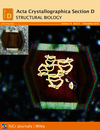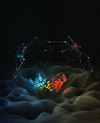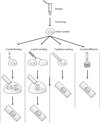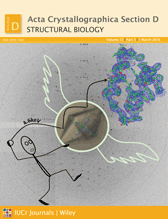issue contents
December 2018 issue
Neutron scattering for the study of biological systems
Edited by Trevor Forsyth and Peter Moody

Cover illustration: Lysozyme crystals obtained in silica gel (dark part of the crystal schematized as linked spheres) regrown from fresh solution [Gavira et al. (2018), Acta Cryst. D74, 1200-1207]. A microscopic photo of the crystal (insert) is shown here with transmitted polarized light. Reinforced gel-grown protein crystals can be a good strategy for the production of stable seeds for the regrowth procedure required for neutron diffraction.
introduction
Free 

An introduction to the special issue on neutron scattering for the study of biological systems.
lead articles
A wide variety of neutron scattering techniques can be applied to obtain information on the structure and dynamics of biological systems on multiple scales. Recent progress is summarized, as are hoped-for future developments in the context of the advent of next-generation neutron sources on various continents.
research papers
Recent work applying neutron and X-ray scattering to elucidate the molecular mechanisms of volatile anesthetics is reviewed.
Small-angle neutron scattering (SANS) is coupled with online size-exclusion chromatography (SEC). The obtained SEC–SANS was combined with SEC–SAXS and utilized to investigate solution structures of phospholipid nanodiscs with and without incorporated membrane proteins.
Open  access
access
 access
accessUsing the unique ability of small-angle neutron scattering to resolve a hydrogen-rich surfactant from a deuterated membrane protein, the results of removing free surfactant from the equilibrium are revealed.
Lysozyme crystals grown in silica gel were reinforced by the incorporation of 100% of the gel, qualifying them as the best source of seeds for the growth of large crystals for neutron crystallography.
Exploring strategies for growing large membrane-protein crystals and the challenges of using neutron macromolecular crystallography to locate H atoms.
Using neutron reflectivity, a comprehensive structural characterization is provided of each step in the formation of a protein-tethered bilayer lipid membrane. Relevant physical parameters of self-assembled monolayers, surface-captured detergent-stabilized protein and the bilayer lipid membrane reconstituted by dialysis around the surface-captured tethering proteins are reported.
This article reports the fabrication and characterization of simple lipid-bilayer models of fungal membranes to allow study of their dynamics and interactions under modelled in vivo conditions.


 journal menu
journal menu
























